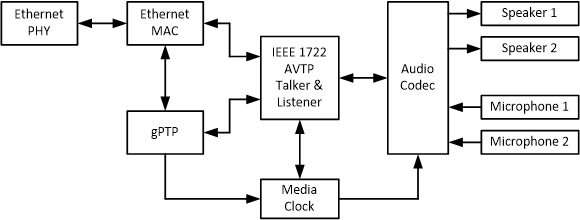SNAA333 April 2020 CDCE6214-Q1
- eAVB Media Clock Synchronization Using CDCE6214-Q1 Clock Generator
3 AVB End Station Architecture
A high level system block diagram of an AVB end station (Talker and Listener) with time-sensitive applications is shown below:
 Figure 3. AVB End Station Block Diagram – Talker and Listener
Figure 3. AVB End Station Block Diagram – Talker and Listener An AVB end station consists of the following components:
- A gPTP (generalized Precision Time Protocol) subsystem provides a common local time reference by exchanging timestamped packets with the Grandmaster clock. A grandmaster clock is the best clock selected to provide a common time reference to all Ethernet nodes. This common time reference, as in time of day, is called Wall Clock.
- An AVTP (Audio Video Transport Protocol) Talker or Listener consists of an AVTP Network Interface and AVTP Stream Packetizer or Depacketizer. The AVTP Talker and Listener interconnect time-sensitive applications across AVB nodes through the Ethernet MAC (Media Access Control) layer. For example, an analog signal collected by a microphone is sampled by the Audio Codec and becomes digital media samples. An AVTP Talker inserts timestamps with a common time reference to the data packets and produces outgoing IEEE 1722 data streams. Similarly, an AVTP Listener interprets an incoming 1722 stream and converts it to digital media samples. The media samples are fed into the Audio Codec to reconstruct the analog signal which is then amplified and played by the speakers.
- A media clock provides the clocking for the Audio Codecs. In other words, the media clock controls the rate at which the Audio Codec samples or restores an analog signal. The Media clock needs to be synchronized between sources and destinations of the media content. For example, if a single audio stream is broadcasted to multiple speakers in different end stations, all the speakers need to reconstruct the audio with exactly the same rate for high quality audio distribution. As another example, if a Listener subscribes to multiple Talkers, media clocks for all Talkers should be synchronized so that the Listener can receive 1722 streams from different sources without need of sample rate conversion.
Details of media clock recovery and synchronization are covered in the next section.